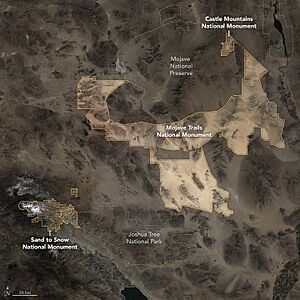Castle Mountains National Monument facts for kids
Quick facts for kids Castle Mountains National Monument |
|
|---|---|

Castle Peaks (Mojave National Preserve) as seen from Castle Mountains National Monument
|
|
| Location | San Bernardino County, California |
| Area | 20,920 acres (8,470 ha) |
| Authorized | February 12, 2016 |
| Governing body | National Park Service |
| Website | Castle Mountains National Monument |
The Castle Mountains National Monument is a special protected area in the Mojave Desert in California. It's called a U.S. National Monument. This amazing place is in the northeastern part of San Bernardino County.
The monument covers a huge area of 20,920 acres. It is located between two major highways, I−15 and I−40. It's also northwest of the Colorado River.
Exploring the Castle Mountains
This national monument protects a part of the Castle Mountains. This mountain range stretches across San Bernardino County in California and into Clark County, Nevada. The mountains are found at the northeastern end of a valley called Lanfair Valley.
The highest points in the Castle Mountains are Hart Peak, which is about 5,543 feet (1,690 m) tall, and Linder Peak, which is about 5580 ft tall. These mountains run in a southwest-to-northeast direction. To the southeast, you can find the Piute Range.
The Castle Mountains National Monument is almost completely surrounded by another large protected area. This is the Mojave National Preserve, which is managed by the National Park Service.
There is a small area inside the monument called the Castle Mountain Mine Area. This area used to be a gold mine. Mining stopped there in 2001. The plan is that after any future mining or cleanup is done, this mine area will also become part of the National Park Service land.
How it Became a National Monument
The Castle Mountains National Monument was officially created on February 12, 2016. It was designated by President Obama. On the same day, two other national monuments were also created in Southern California. These were the Mojave Trails National Monument and the Sand to Snow National Monument.
Out of these three new monuments, Castle Mountains is unique. It is the only one managed by the National Park Service. The other two are managed by different government groups. These include the Bureau of Land Management or the United States Forest Service.




